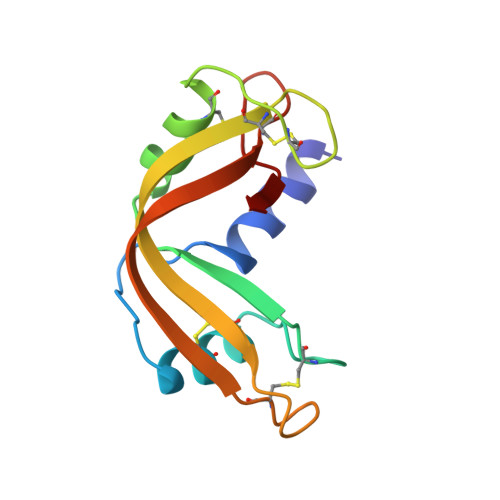The three-dimensional structure of human RNase 4, unliganded and complexed with d(Up), reveals the basis for its uridine selectivity.
Terzyan, S.S., Peracaula, R., de Llorens, R., Tsushima, Y., Yamada, H., Seno, M., Gomis-Ruth, F.X., Coll, M.(1999) J Mol Biology 285: 205-214
- PubMed: 9878400
- DOI: https://doi.org/10.1006/jmbi.1998.2288
- Primary Citation of Related Structures:
1RNF, 2RNF - PubMed Abstract:
The RNase 4 family is unique among RNase enzymes, displaying the highest level of sequence similarity and encompassing the shortest polypeptide chain. It is the only one showing high specificity. The human representative is an intracellular and plasma enzyme, first isolated from colon adenocarcinoma cell line HT-29. The crystal structures of human recombinant RNase 4, unliganded and in complex with d(Up), have been determined, revealing in the unique active site an explanation for the uridine specificity. Arg101, at a position not involved in catalysis in the other RNase enzymes, penetrates the enzyme moiety shaping the recognition pocket, a flip that is mediated by the interaction with the (shorter chain) C-terminal carboxylate group, providing an anchoring point for the O4 atom of the substrate uridine. The bulky Phe42 side-chain forces Asp80 to be in the chi1=-72.49 degrees rotamer, accepting a hydrogen bond from Thr44, further converting the latter into a hydrogen bond acceptor. This favours an interaction with the -NH-donor group of uridine at position 3 over that with the =N-acceptor of cytidine. The two chemical groups that distinguish uracyl from cytosine are used by the enzyme to discriminate between these two bases.
- Centre d'Investigació i Desenvolupament, C.S.I.C., Jordi Girona, 18-26, Barcelona, 08034, Spain.
Organizational Affiliation:

















